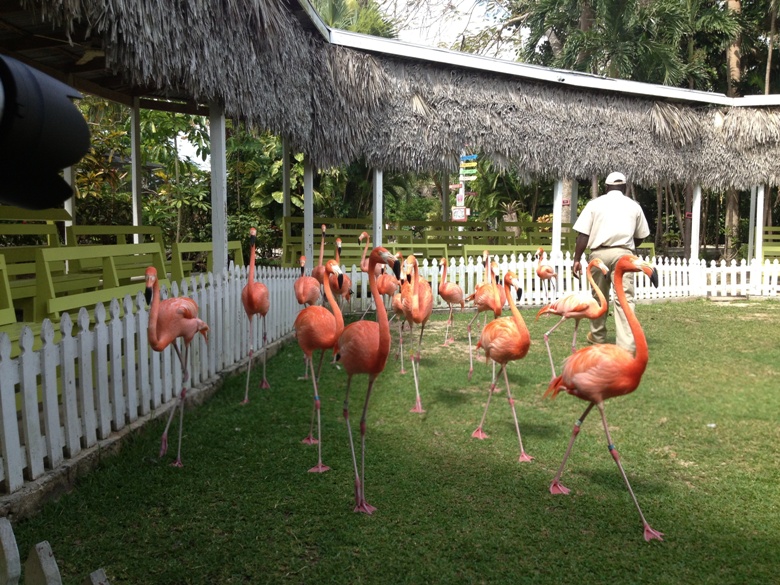In the Bahamas — what’s Nassau without Pink Flamingoes?


DAY TWO — “Forward, march!
“Pick it up,” says the drill sergeant. “Let’s go! “
No, he’s not talking to a bunch of raw recruits. He’s talking to Flamingoes.
That’s right. Gorgeous pink flamingos. Flamingos, in case you didn’t know, are the national bird of the Bahamas with colony of some 30,000 in the southernmost Bahamian island of Inagua.
Here at the Ardastra Gardens, Zoo and Conservation Centre in Nassau there are 60 of them that have been taught to march in formation, about face and entertain visitors, some of whom (including me) are invited inside the fenced area for a closer encounter.
They are five feet tall with a wing span that is just as long. And in case you worry about them in captivity they live far longer—more than 70 years as compared to 40.
How long can you stand on one foot, like a flamingo does? “ I almost broke my leg trying,” said three-year-old Braydon Buckwalter, visiting with his family from Pennsylvania. “It’s hard to stand on one foot!”
The kids were equally excited by the chance to feed the Lorry Parrots, native to Australia and Tasmania. We hold out apple slices and they perch on our hands, our heads, our shoulders…they are so bright too—blue and yellow and red.
The Bulusu-Mallajosyula family had to coax their kids away from Atlantis’ famous water slides to come here. “To be so close to a flamingo is a wonderful experience,” said Ravi Mallajosyola, here with his wife and young son and daughter from Boston.
“But,” added his wife Madhury Bulusu, “The kids just want to be in the water!”
There’s certainly plenty of that here in Nassau, the Bahamas capitol just 179 miles east of the Florida Coast. It is just 21 miles long and seven miles wide and a bridge links Paradise Island to New Providence Island—Nassau’s other name.
Some call it cruise ship capitol of the world. Some days as many as eight ships are in port, bringing 25,000 people to the quaint streets. As many as seven million people a year visit this island which is home to 250,000, said Romeo Farrington, our tour guide.
One of the first things they do is head to the beach—or out on a snorkel boat from Stuart Cove’s Dive Bahamas, the largest-snorkel and dive operation in the Bahamas. You can take a scuba lesson too, dive with sharks or complete your scuba course here, finishing your certifying dives in three days if you have done the “classroom” work on line.
And what a beautiful underwater classroom you have here—turtles and rays, schools of tropical fish on reef that circles the island and that is named Little Elvis, Golden Cay, Sim’s Point and Nari Nari. Some spots are just 20 minutes from shore. “It is different every day,” said Gary Van Hoeuk, dock manager for Stuart Cove’s, which shepherds thousands of divers and snorkelers a year. Kids as young as five can snorkel, he said.
His tips: Make sure your mask isn’t too tight and make sure you don’t put your head too far forward in the water or you are guaranteed to get water in your mask.
Most important, be relaxed and enjoy the underwater world here—It really is amazing!
Finish the day with some local Bahamian fare at Arawak Cay, a collection of stands and restaurants that serve local fare like conch salad and conch fritters, just-caught snapper and grouper and of course the Bahamian staple peas and rice and baked macaroni and cheese. This isn’t a tourist trap either—you’ll find as many locals eating and drinking here as visitors.
“Food is the universal connector,” said Alanna Rodgers, founder of Tru Bahamaian Food Tours, Looking around at the crowd at Arawak Cay on a Sunday night. Her tour shows visitors the variety of food here—Greek, Jamaican, plantains, fresh Mango juice, even the chance to make your own chocolate at Graycliff Chocolatier.
I’m going to put that on my must-do list for next time.
